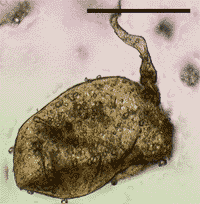New fossil
find pushes age of terrestrial fungi back 60 million years, to
the same era when green plants pulled themselves onto land
14
Sep 2000
By
Robert Sanders, Media Relations
|



Light
microscope picture of a fossil fungal spore with attached
hypha from the Ordovician, 460 million years ago. (c)Science
Magazine CREDIT: Dirk Redecker/UC Berkeley

|
Berkeley
- Fossils from a Wisconsin roadcut show clearly that fungi
and green plants moved from water onto land at about the same
time, bolstering the theory that fungi helped plants successfully
invade the land.
The
newly discovered fossils - microscopic spores and threads
in sediments dating from 460 to 455 million years ago - push
the origin of land-based fungi back some 55 to 60 million
years to about the same era that green plants invaded land,
said Dirk Redecker, a postdoctoral researcher at the University
of California, Berkeley.
"The presence
of both organisms at the same time suggests that there could
have been such an interaction, and that organisms even then
were interdependent," Redecker said.
Redecker
and his colleagues at the University of Wisconsin, Madison,
report their discovery of the fossil fungi in the Sept. 15
issue of Science.
Plant/fungus
interactions are widespread today, with between 80 and 90
percent of all green plants forming associations with so-called
mycorrhizal fungi. These fungi grow around and into plant
roots and help them absorb minerals and water, giving plants
a substantial competitive advantage, said coauthor Linda K.
Graham, a professor of botany and environmental studies at
the University of Wisconsin, Madison.
"Plants
without mycorrhizal fungi are competitively inferior," Graham
said. "Though they won't die, in a highly competitive situation
or places with a dearth of resources, mycorrhizal fungi function
as an auxiliary root system to provide additional nutrients."
The researchers
caution that the fossil fungi they discovered and report in
Science show no evidence of an association with green plants.
However, similar modern fungi from the genus Glomus form a
simple association with modern liverworts and hornworts, relatives
of the only group of land plants around 460 million years
ago.
In addition,
mycorrhizal fungi have been found in fossils as old as 400
million years, in company with later, more evolved vascular
plants.
|



Parasites
or mutualists? Land plants and Glomalean fungi were around
460 million years ago, but it's not quite clear what they
did together. CREDIT: Dirk Redecker/UC Berkeley

|
Together,
these provide strong circumstantial evidence that fungi played
a major role in helping plants move successfully onto land,
Redecker said.
Graham
obtained the fossil-bearing rocks from a roadcut near Madison,
Wisc., not knowing what kinds of fossils they contained. It
wasn't until undergraduate Robin Kodner etched the rocks with
strong acid that she and Graham saw tiny structures that a
colleague suggested might be fossilized fungal spores.
The two
sought out Redecker, who works in the laboratory of Thomas
Bruns, an associate professor of plant and microbial biology
in the College of Natural Resources at UC Berkeley. Redecker
is an expert in the evolution of fungi, and he was able to
identify them as spores and hyphae - tiny root-like threads
- of fungi similar to those in the Glomus genus. Glomus is
a member of the larger group Glomales, which is more primitive
than the better known fruiting fungi, the Ascomycetes and
Basidiomycetes.
With the
new fossil evidence, plus other previously found fossil fungi,
Redecker estimated that the Ascomycetes and Basidiomycetes
diverged from Glomales about 600 to 620 million years ago.
This fits
well with a recent phylogenetic study of fungi by M. L. Berbee
and John Taylor, UC Berkeley professor of plant and microbial
biology and a curator at the University Herbarium. They compared
ribosomal RNA from many species of fungi and calibrated them
against geologic time to obtain an approximate time estimate
for the origin of fungal lineages. They concluded in a book
chapter published this year in The Mycota (vol. VII B) that
the major lineages of land fungi - Basidiomycetes, Ascomycetes
and Glomales - may have diverged from each other about 600
million years ago.
Colonization
of the land masses by the first land plants is believed to
have happened in the Ordovician (505-440 million years ago),
Redecker said. However, no pieces of land plants large enough
to see without using a microscope have yet been found from
that epoch. This may be due to the fact that the first land
plants mainly consisted of soft, quickly decaying tissue like
today's hornworts and liverworts. Only fossil spores and microscopically
small parts of resistant protective tissue indicating the
presence of those plants have been found.
The oldest
and most widespread mycorrhizal association is arbuscular
mycorrhiza, and the great majority of plants form arbuscular
mycorrhizae with fungal partners from the taxonomic group
Glomales. Some of the earliest known land plants, which originate
from the Devonian (400 million years ago), have been shown
to contain structures indicative of arbuscular mycorrhizae.
The Devonian
plants containing the finely branched structures called arbuscules
did not have a vascular or water conduction system, though
they were already relatively complex, at a stage between vascular
plants and bryophytes (mosses, liverworts and hornworts),
Redecker said. Nevertheless, at the same time in the same
site, vascular plants already were present.
###
.
|